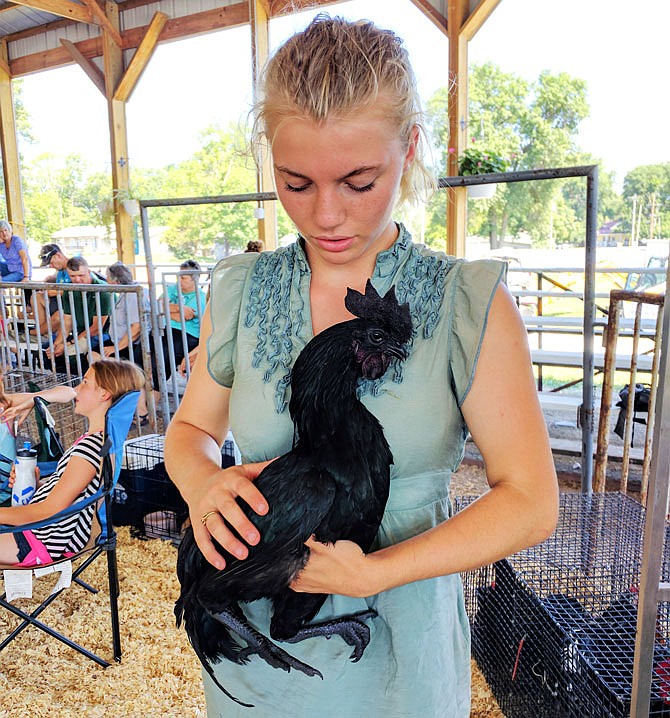AUXVASSE, Mo. - For sheer variety, color and personality, it's hard to beat the small animal classes at the Callaway Youth Expo.
There's the tiny, pert Belgian Dwarf rabbits. There's the Frizzle chicken, so ruffled it looks like a crab fisherman in a storm. There's the goth of the chicken world, the Ayam Cemani.
Savanna Bilyeu brought those last two, along with a feathery rainbow of other chickens. Friday was the 15-year-old's first show.
"I wasn't sure what to expect," Bilyeu said.
She's spent months perfecting her flock of Ayam Cemani. The uncommon breed hails from Indonesia, and its claim to fame is it's all black, inside and out.
"If you open its mouth, it's black in there as well," she said. "In the light, they have multiple different colors."
When light gleams off an Ayam Cemani's black feathers, it reveals beetle-greens and blues.
Aside from being striking - and, rumor has it, tasty - the breed is fabulously expensive. Day-old chicks sell for up to $200, Bilyeu said.
"She said, 'That's my FFA project,' and I said, 'You couldn't have picked a cheaper kind?'" mother April Bilyeu interjected.
The family made the project affordable by purchasing imperfect chicks that had a little color, or "leakage." Savanna Bilyeu selectively bred the best of the best to drive out every spot of color.
"If it's got a little leakage as a chick, and you can tell pretty early, I'll sell them for $35 each," she said.
In truth, chickens are more of her mom's passion, Bilyeu admitted. She's saving up to purchase full-blood Boer goats, and recently bought her first, named Lizzie.
"(Raising animals) is kind of like having a baby," she said. "It's watching them grow and seeing how beautiful they become. When you raise them you fall in love with them."
Bilyeu was bitten by the farming bug fairly recently. Last year, the Fulton resident was struck by a car while crossing the street and suffered a skull fracture. As she recovered, Bilyeu said, she looked to the future.
"I was like, I want to do something with my life," she said. "I want to be a farmer. I want to raise cattle and goats and sheep. But I'm probably not going to do chickens."
Rare rabbits
Bilyeu wasn't the only one to bring an uncommon breed to Wednesday's show.
Casper Safranski, 11, brought his champion American. At 4, the buck is almost ready to retire from breeding and showing, Safranski said.
"I brought him my first year competing and we won in showmanship," he said.
By breeding Americans, Safranski is doing his part to help preserve a faltering breed.
"They were the most popular rabbit breed in the 1930s, but now they're the rarest breed in America," he said.
The reason for the American's decline in popularity, Safranski explained, is that they're a dual-purpose breed. They're bred for both their fur and their meat.
"But then people bred Angoras, which are giant fuzzballs, and New Zealands, which are 18 pounds," Safranski said.
The American couldn't compete, but Safranski said he loves them.
"They're very successful when I show them," he said.
It also helps that they breed - well, like rabbits.
This year, Levi Huffman, 9, took home the top prizes with his Californian rabbits. His rabbits impressed the judge with their abundance of muscle and top-quality fur.
Win or lose, this year's competitors seemed to have a good time. If animals can understand English, however, the same might not be able to be said for some of them.
"They're going to die tomorrow," Caleb Sobba said of his chickens. "That's why I don't name them."

